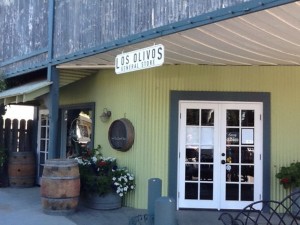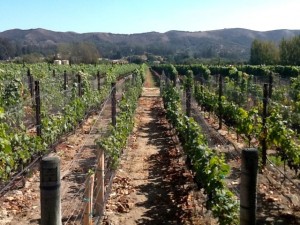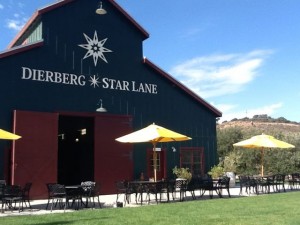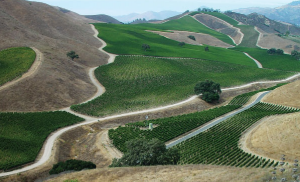The Santa Ynez Valley: “A little paradise for wine grapes.”
“Toto, we’re not in Napa anymore…”
I felt as disoriented as Dorothy and her little dog when I landed in the middle of Santa Barbara County’s Santa Ynez Valley. I was supposed to be in Wine Country, but where were the sights so familiar in the Napa Valley? Where were the gigantic Tuscan tasting rooms crowded together along the roadway? Where were the high-end restaurants grudgingly serving $200 a plate lunches? Where were the traffic jams?
Instead, I saw the brick-front Lompoc Chamber of Commerce, Circa 1892. It sits across from Sissy’s Cafe, where they make a mean lentil soup. I saw the Los Olivos General Store, and further up the street was Jedlicka’s Saddlery, where working ranch hands still buy bridles and belt buckles. I saw the pseudo-Dutch village of Solvang, which was, well, weird — but features an antique dealers showroom with one of the country’s finest collections of clocks.
And I tasted some very, VERY good wine.
The Santa Ynez Valley is south of San Francisco, just a few hours north of Los Angeles, and close enough to Santa Barbara for a nice day trip. It’s blessed with wonderfully moderate temperatures, and if you’re a wine geek like me, you know that the valley runs east-west, splitting the coastal hills and allowing morning fog and cool afternoon breezes to blow in from the ocean. This creates the longest and coolest growing season in California, and when you add endless summer sunshine, low rainfall and well-drained soils, you’ve got a little paradise for wine grapes.
Our first taste of paradise came at Melville Winery, which nestles in the cool Santa Rita Hills appellation on the west side of the valley. This is where the Melville family and winemaker Greg Brewer craft some amazing estate wines. They’ll tell you it’s all about their vineyard practices, using techniques such as these:
- High density planting creates really intense flavors in the fruit. Vines must compete for nutrients from the soil and yields are very, very low.
- Leaves are pulled to expose the stems to the sun. The stems become dry and brown so they can be included in whole-cluster fermentation without adding green flavors to the wine.
- Their Pinot Noirs see no new oak, which seemed like sacrilege: what’s red wine without oak? But the crafty folks at Melville let the dried wood from the stems act as their “oak.” It imparts that soft vanilla undertone without overpowering the fruit.
I loved several of their Pinot Noirs, including the Estate Pinot which I’ve reviewed in the past (read about the Melville 2009). My first love was Melville Sandy’s Pinot Noir 2010. It’s made with fruit from a four-acre block planted on very sandy soil, and named after a woman named, you guessed it, Sandy. The nose hit me with sweet raspberry notes, and the palate offered intense dark cherry/berry fruit without weight or jamminess. Yumm…
Melville Carrie’s Pinot Noir 2010 uses fruit from a five-acre block that sits atop an exposed mesa, where the roots have to reach deep into the soil in search of nutrients. This creates the “darkest and most powerful” of their Pinots. I loved the luscious berry compote on the nose, and the rich, textured body of this Pinot. Again, there was plenty of lush fruit and layers of spice, but it was all balanced by good natural acidity.
A few miles further up the road, we found what looked like a big old Midwestern cattle barn plopped down in wine country. It houses sister wineries Dierberg and Star Lane. Between the two of them, they capture the diversity of the Santa Ynez Valley:
- Dierberg makes Chard and Pinot Noir from vineyards in the Santa Rita Hills and Santa Maria Valley, which sits further north and eight miles closer to the cooling influence of the Pacific Ocean.
- Star Lane grows Syrah and Bordeaux varietals in Happy Canyon, otherwise known as the Banana Belt of Santa Barbara County. The owners were so impressed with this warm-climate region that they bought a whopping 8,000 acres — about one third the total area of the Canyon.
Dierberg’s Santa Maria Valley Chardonnay 2009 was an absolute stunner. Delicate and rich at the same time, I loved the bright pear and tropical fruit with notes of pineapple and butterscotch. The palate was lush but the finish was tangy and crisp, showing the great natural acidity that balances this wine. Thanks to aging in large oak vessels that impart just a hint of toast, and minimal secondary fermentation that maintains the natural acidity, this Chard will actually age like a White Burgundy. If you can wait that long to drink it…
Besides plenty of high ratings, Dierberg has the distinction of being served to a bevy of international dignitaries at the 2012 NATO Summit (that was the 2007 Syrah). That’s high praise, indeed.
Star Lane is like the big, bad-ass sister next to refined Dierberg. Their vineyards in Happy Canyon are unexpectedly warm for Santa Barbara County,
with more degree days and less rain than almost all of the Napa Valley. They’re also among the highest elevation, with grapevines climbing up the lower slopes of the San Rafael Mountains. They can make big reds here, like Star Lane Estate Happy Canyon 2007. Five years after vintage date this beauty is bold, rich and soft. A blend of Bordeaux varietals plus Syrah, it opens with rich creme de cassis and vanilla, following with dark berries, mocha, and a little exotic spice. The mouthfeel is juicy and the tannins are beautifully supple. A few bottles left the winery in the back of my car, and I can’t wait to revisit them with an appropriate meal to match.
There’s more to tell but I’m out of space and out of time. Stay tuned for the final installment of our adventures in the Santa Ynez Valley. Cheers!




